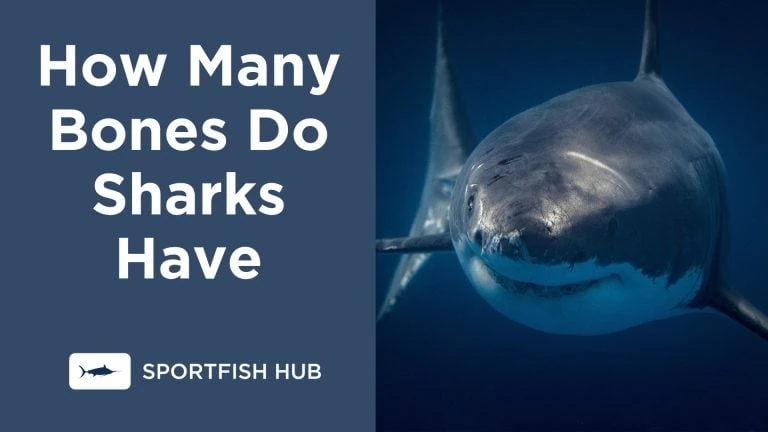Sharks have thrived as apex ocean predators for over 400 million years thanks in large part to their unique skeletal structure. But how many bones do sharks actually have?
In this article, we’ll explore the skeletal structure of sharks, including their jaws, teeth, and the number of bones they have.
- Do Sharks Have Bones?
- How Many Bones Do Sharks Have?
- Are Shark’s Teeth Made of Bones?
- What Are Shark’s Jaws Made Of?
- Parts of a Shark Skeleton
- Shark Skeletons Are Perfectly Adapted Hunters
- Other Interesting Facts About Shark’s Bones
- FAQ
- Are sharks able to regrow cartilage if it becomes damaged?
- How do shark and whale skeletons differ?
- Why are shark vertebrae different from land animals?
- How does climate warming threaten shark skeletons?
- Conclusion
Do Sharks Have Bones?
The short answer is no, sharks do not have bones in the way that humans or other mammals do. Instead, sharks have a skeleton made entirely of cartilage, a flexible and lightweight material that is also found in human ears and noses.
This cartilaginous skeleton gives sharks the flexibility and speed they need to thrive in aquatic environments.
There are some key advantages of cartilage versus bone:
| Cartilage | Bone |
|---|---|
| Lower density | Higher density |
| Lighter weight | Heavier weight |
| Flexibility | Rigidity |
| Mobility | Restricted movement |
| Tough and durable | Brittle |
How Many Bones Do Sharks Have?
Since sharks do not have traditional bones, it’s more accurate to ask how many cartilaginous structures they have. The number can vary depending on the species of shark, but all sharks have a similar basic skeletal structure. This includes a spinal column, a cranium to protect the brain, and a series of gill arches to support the gills.
You might also enjoy reading: 15 Interesting Facts About Sharks
Are Shark’s Teeth Made of Bones?
Shark’s teeth are not made of bone but rather of dentin, a hard, bone-like substance that is also found in human teeth.
Sharks’ teeth are incredibly strong and are constantly replaced throughout the shark’s life. In fact, some sharks can go through over 30,000 teeth in their lifetime!
What Are Shark’s Jaws Made Of?
Like the rest of their skeleton, a shark’s jaws are made of cartilage. However, the cartilage in a shark’s jaws is much denser and stronger than the cartilage found elsewhere in its body. This allows sharks to exert incredible force when biting down on their prey.
Parts of a Shark Skeleton
A shark’s internal skeleton contains these main elements:
- Head – Includes the skull, jaws, and gill arches made of fibrous cartilage tissue.
- Backbone – Formed from vertebral columns of cartilage discs stacked together.
- Fins – Cartilaginous fin rays provide structural support inside fins.
- Skin – Reinforced by small dentine plates called dermal denticles.
| Shark Skeletal Parts | Composition |
|---|---|
| Skull | Fibrous cartilage |
| Jaws | Elastic cartilage |
| Vertebrae | Cartilage discs |
| Ribs | None |
| Fin rays | Soft cartilage |
| Dermal denticles | Dentine |
Shark Skeletons Are Perfectly Adapted Hunters
After evolving as ocean predators for millions of years, natural selection has perfected shark anatomy into an ideal hunting form. From their hydrodynamic shape down to the smallest details, sharks display incredible adaptation:
- Streamlined, torpedo-shaped skulls and jaws reduce drag as sharks swim in pursuit of fast prey.
- Highly flexible cartilage skeletons allow quick reflexive bursts of acceleration to capture their target.
- Lightweight but extremely tough cartilage holds up against massive forces generated when restraining struggling prey.
- Conveyor belt-like tooth replacement provides endless razor-sharp points for grip and tearing.
- Dermal denticle scales decrease surface friction, allowing smooth and efficient movement through the water.
Other Interesting Facts About Shark’s Bones
- Sharks are part of a group of fish known as elasmobranchs, which also include rays and skates. All elasmobranchs have cartilaginous skeletons.
- The cartilage in a shark’s skeleton is not as dense as bone, which helps to reduce their weight and allows them to be more buoyant in the water.
- Despite not having bones, sharks do leave behind fossils. This is because their teeth, which are made of dentin and enamel, can fossilize over time.
FAQ
-
Are sharks able to regrow cartilage if it becomes damaged?
Yes, sharks have some capacity to regenerate lost or damaged cartilage since they retain stem cells throughout life. This helps repair skeletal injuries.
-
How do shark and whale skeletons differ?
Whales have bone skeletons adapted for terrestrial life, while shark cartilage skeletons are designed for aquatic mobility and hunting.
-
Why are shark vertebrae different from land animals?
Shark vertebrae connect to each other via cartilage rather than fused bone processes, allowing greater flex and mobility.
-
How does climate warming threaten shark skeletons?
Rising ocean acidity may hinder cartilage formation in sharks by depleting carbonate ions needed to build their skeletons.
Conclusion
In conclusion, the skeletal structure of sharks is a testament to their evolutionary success. Their cartilaginous skeletons provide them with the flexibility and speed they need to be apex predators in their environments, and their powerful jaws and teeth allow them to take down a wide variety of prey. So, while sharks may not have bones in the traditional sense, their unique skeletal structure is perfectly adapted to their life in the ocean.













